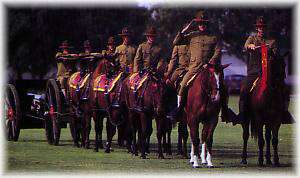Fort Sill History
category : Forts
 The site of Fort Sill was staked out on January 8, 1869 by Maj. Gen. Philip H. Sheridan who led a Campaign into Indian Territory to stop hostile tribes from raiding border settlements in Texas Kansas.
The site of Fort Sill was staked out on January 8, 1869 by Maj. Gen. Philip H. Sheridan who led a Campaign into Indian Territory to stop hostile tribes from raiding border settlements in Texas Kansas.Sheridan's massive winter campaign involved six cavalry regiments accompanied by frontier scouts such as "Buffalo Bill" Cody, "Wild Bill" Hickok, Ben Clark and Jack Stilwell. Troops camped at the location of the new fort included the 7th Cavalry, the 19th Kansas Volunteers and the 10th Cavalry, a distinguished of black "buffalo soldiers" who constructed many of the stone buildings still surrounding the old post quadrangle.
At first the garrison was called "Camp Wichita" and referred to by the Indians as "the Soldier House at Medicine Bluffs." Sheridan later named it in honor of his West Point classmate and friend, Brig. Gen. Joshua W. Sill, who was killed during the Civil War. The first post commander was Brevet Maj. Gen. Benjamin Grierson and the first Indian agent was Colonel Albert Gallatin Boone, grandson of Daniel Boone.
Peace Policy
Several months after the establishment of Fort Sill, President Grant approved a peace policy placing responsibility for the Southwest tribes under Quaker Indian agents. Fort Sill soldiers were restricted from taking punitive action against the Indians who interpreted this as a sign of weakness. They resumed raiding the Texas frontier and used Fort Sill as a sanctuary. In 1871 General of the Army William Tecumseh Sherman arrived at Fort Sill to find several Kiowa chiefs boasting about a wagon train massacre. When Sherman ordered their arrest during a meeting on Grierson's porch two of the Indians attempted to assassinate him. In memory of the event, the Commanding General's quarters were dubbed Sherman House.
Red River Campaign
In June 1874 the Comanches, Kiowas and Southern Cheyennes went on the warpath and the South Plains shook with the hoofbeats of Indian raiders. The resulting Red River Campaign, which lasted a year, was a war of attrition involving relentless pursuit by converging military columns.
Without a chance to graze their livestock and faced with a disappearance of the great buffalo herds, the hostile tribes eventually surrendered. Quanah Parker and his Quohada Comanches were the last to abandon the struggle and their arrival at Fort Sill in June 1875 marked the end of Indian warfare on the south Plains.
Until the territory opened for settlement, Fort Sill's mission was on of law enforcement and soldiers protected the Indians from outlaws, squatters and cattle rustlers.
The Frontier Disappears
The Last Indian lands in Oklahoma opened for settlement in 1901 and 29,000 homesteaders registered at Fort Sill during July for the land lottery. On August 6 the town of Lawton sprang up and quickly grew to become the third largest city in Oklahoma.
With the disappearance of the frontier, the mission of Fort Sill gradually changed from cavalry to field artillery. The first artillery battery arrived at Fort Sill in 1902 and the last cavalry regiment departed in May 1907.
The School of Fire for the Field Artillery. was founded at Fort Sill in 1911 and continues to operate today as the world renowned U.S. Army Field Artillery School. At various times Fort Sill has also served as home to the Infantry school of Musketry, the School for Aerial Observers, the Air Service Flying School, and the Army Aviation School.
Today as the U.S. Army Field Artillery Center, Fort Sill remains the only active Army installation of all the forts on the South Plains built during the Indian wars. It serves as a nation historic landmark and home of the Field Artillery for the free world.
Phone: 580-442-4500
Our Website:sill-www.army.mil
Come visit us in Fort Sill, Oklahoma